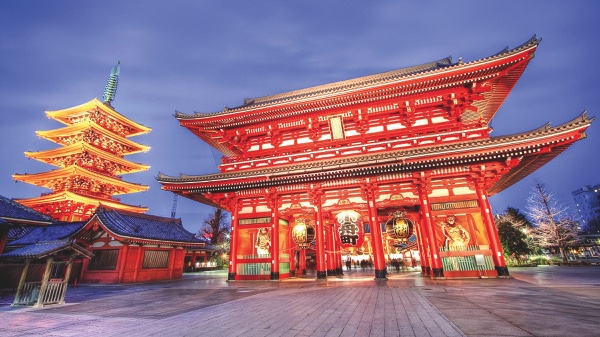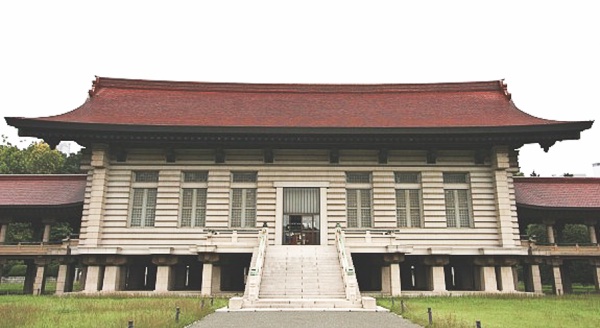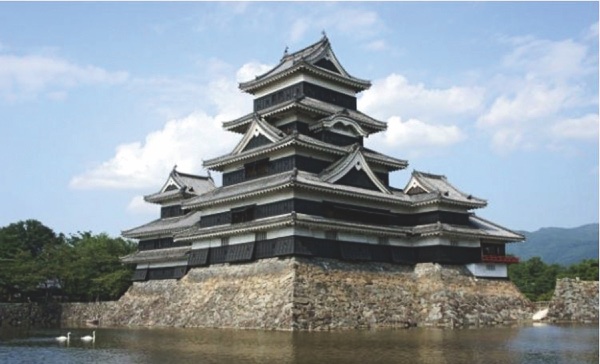Sun City residents David and Karen, along with their two sons, recently visited Tokyo.
It was a return for their youngest son who had studied there one semester during college several years ago and wanted to revisit to see what had changed and anything he had missed previously. Ok, so first, how do you link up and get there?

Asaksa Kannon Temple. (Photos provided)
David decided to drive up to Boston to meet his sons who live in New Hampshire, and the four of them would fly from there to Japan. This turned into a three day journey of its own and brought back memories from when David lived in New Hampshire years ago. Boston itself is an interesting stopping point with the innate Revolutionary history that surrounds it: Bunker Hill, Paul Rever’s church steeple, the USS Constitution, The Minutemen, and numerous other points of interest from the American Revolution. Plus you have the food pleasures of the Italian east-end section, fresh lobster, and much more.
But that is not why he and his family went.
With the first leg complete, the second began from Boston to Tokyo. It was a 12-hour flight on Japan Airlines to Tokyo. With both the length of the flight and the time changes, approximately 9 hours difference, you wind up tired and slightly disoriented.
So what to do first?
Well, you don’t actually land in Tokyo since the airport is far outside the city. The best and easiest way to get into town – high speed train. Unless you like driving in heavy traffic, it’s the easiest route to take.

Meiji Jingu Treasure House.
Finally, you’re in town. Now how to traverse the area? The subway offers an excellent method for local travel. Beware of rush hour as the cars get packed. They even have “pushers” to help stuff more people in so the doors will close! Most of the routes also had signs in English to help people get to the correct destination. So, if you know where you’re going and have a good map, you should be able to negotiate the city.
Whether you’re driving or walking, you’ll also find a few major differences in how they drive in Japan. They drive English-style, or as we would say, “on the wrong side of the road,” so it’s very important to look both ways prior to crossing the street. Also, bicycles make up a major segment of traffic, so sometimes you have to share the sidewalk with them.
Why so crowded? It turns out that Tokyo is listed as the World’s largest city with over 38 million people in the metropolitan area. Compare that with Chicago’s 9.5 million metro-wide with everyone trying to get to work or home at the same time. You may also be surprised to find that even with that large a population, it’s a very clean city. Many cabs have auto-opening doors so the driver doesn’t have to get out, nor have to touch a handle a number of other people have touched! Doormen and porters may also be wearing gloves as well as the person operating the elevator, heaven forbid you should have to touch a floor button after someone else!
Most of their meals were, yes, Japanese, but they also enjoyed the German and Italian food. Like any major city in the world, other cultures, food and customs have intermingled with the local populous. If you really want to get into the local food scene, practice with chopsticks as it’s still the utensil of choice in many smaller food venues.
So where do we start in our tour? The temples and shrines are generally dedicated to the religions, and castles.
Castles, really?
Yes, for shoguns, monarchs, warloards and/or emperors. They’re not European or Disney style castles, but they are fantastic. The culture in Japan is very interesting as it differs in many ways from ours. For example, Senso-ji is Tokyo’s oldest Buddist temple. Known in Japan as the temple of the Asakusa Kannon, it draws over 30 million visitors every year. Even more amazing is the fact it’s based on a statue of a Buddha found in the river and has been hidden from view since its first appearance over 1,400 years ago. Even more amazing is the number of Buddhas that exist. If you do a search, you’ll get as many different answers as there are, well, Buddhas!

Castle Japan.
The Shinto shrine, Meiji Jingu, established in 1920, is dedicated to the memory of Emperor Meiji and Empress Shoken. Shinto is Japan’s ancient, original religion, and it is deeply rooted in the way of Japanese life, especially since it has no founder, no holy book, nor even the concept of religious conversion. Shinto values, for example, include harmony with nature, and Japanese citizens planted over 100,000 trees surrounding the shrine to honor the Emperor and Empress.
Matsumoto Castle was begun in 1504 and is among the most outstanding castles in Japan. It was attacked, captured and has changed hands many times over the years. Each new “owner” made changes to the architecture and battlements in hopes of surviving the next attack.
Ok, so there are tons of castles, shrines and temples, but what is the Number One most visited spot in Tokyo? You might think of the many outstanding parks, or towers, but this is not even close.
The number one spot belongs to Tsukiji Market, the largest wholesale market for fish, fruits, and vegetables in central Tokyo. It’s the most famous wholesale market in Tokyo and best known as one of the world’s largest fish markets, handling over 2,000 tons of marine products per day. That tuna you had in your sushi most likely came from this market. If you’re lucky, you may get to visit when they are having the tuna auction and see 400 pound tunas being offered for sale to the highest bidder. Last year the largest sold for almost $118,000 (almost $300/lb)!
Want to take a road trip from downtown? Daily tours to Mount Fuji will take you to the sacred mountain, revered for its near perfect conical shape. For those willing, the tour may take you to the top or you can even hike it if you’re more adventurous.
David and his wife really enjoyed the visit and might even go back some day, but this trip was enough for now as there are other places of interest they want to visit.




